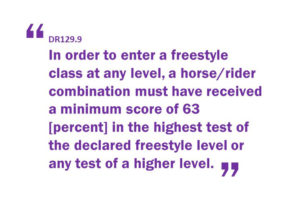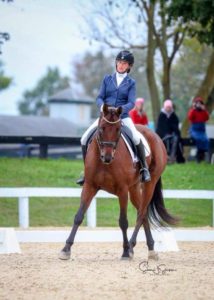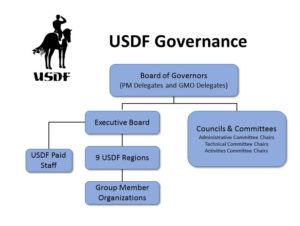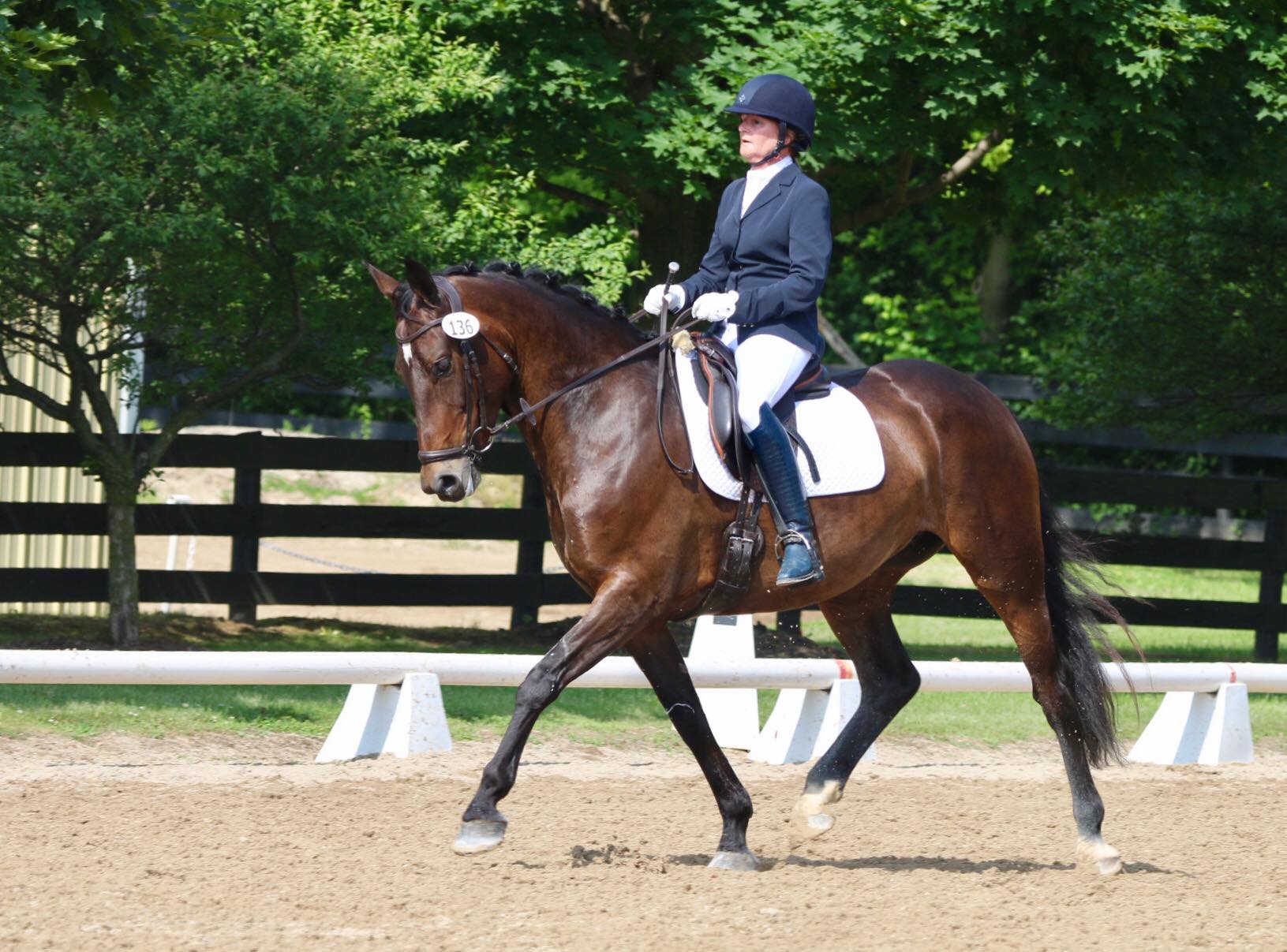Changes to the Qualification Score for Freestyles Stirs Up the Talk at the USDF Convention
by Katherine Rosback
(Above: Long time Indiana and IDS rider Clare Ross and her FHF Indyanna doing First Level Freestyle)
 IDS members Kay Dixon, Bonna McCuiston, and Ken Levy made the trek out to Salt Lake City, Utah to attend the annual USDF convention on November 30 – December 1st. While there were the usual meetings and discussions on everything from Safe Sport to new tests, it was a rule change that created the most “buzz” this year.
IDS members Kay Dixon, Bonna McCuiston, and Ken Levy made the trek out to Salt Lake City, Utah to attend the annual USDF convention on November 30 – December 1st. While there were the usual meetings and discussions on everything from Safe Sport to new tests, it was a rule change that created the most “buzz” this year.
“The issue that created the most confusion and consternation was the change in the freestyle qualifying scores.” observed Kay. “There was a long line of people at the Board of Governors meeting waiting to express their opinion on that topic!” Hallway conversations focused on the change in the qualifying scores with strong opinions on both sides—should it stay at 60% or would it be best to change it to 63%? Does the ruling penalize adult amateurs? Some argued that the intent was to raise the competence of the skill levels—some competitors competing in the freestyles just weren’t demonstrating the proper technical skills. Raising the requirements would raise the competency of those competing in the Freestyles. Others argued that such an increase unfairly penalizes the amateur competitors riding the not-so-expensive dressage horses.

IDS member Karen Taylor is one of several in our club who participate in the Freestyle competitions.
But a significant part of the conversation was not so much about the specifics of the rule change, but that the process by which the rule was changed had somehow bypassed membership input. How was this passed without membership input? Why was such an important ruling not brought up at the Board of Governors (BOG) meeting prior to sending it to the USEF?
For those unfamiliar with the governance processes of the USDF, here’s an explanation of the usual process. The USDF has a number of committees (click here for a list). Issues brought forth by members are worked in committees (the same process that we use at IDS). Thus, when there was a suggestion brought up regarding freestyle qualification percentages, the USDF Judges Committee provided input to the Freestyle Committee, the Freestyle Committee made a recommendation to the USDF Executive Board to increase the percentage, and that governing body subsequently sent it off of the USEF. The USEF voted on the rule mid-June and it went into effect on December 1st, all without input from the BOG or members.
And here are the two points that often cause confusion regarding USDF decision-making.
First, people often think that the USDF governance structure makes all rules for the organization, but that is not true. The USEF is the governing body for equestrian sport and implements programs and policies to protect human and equestrian athletes. Think of it as USDF having a reporting/recommendation role to the USEF. Final rules regarding tests, safety rules, drug regulations, judging criteria, proper dress code, whip length, conduct of classes—are all the responsibility of the USEF. Thus, the USDF committees do their work, and then they pass on their recommendations to the part of USEF that handles dressage competitions.

USDF Governance Structure
The second area of possible confusion is regarding the function of the USDF Executive Board. Unlike most business corporations in which executive committees are at the top of the hierarchy and, therefore, make all of the decisions, this is NOT the case with the USDF. The USDF is a member organization, meaning that its duty is for and governed by the members. As shown in the organizational chart (click here for more details), it is the Board of Governors—the voices that represent you, the member—that are at the top, not the executive committee. And the Board of Governors meeting held every year at the USDF annual convention is one way for member voices to be heard.
As Kay explains, “The Board of Governors meeting is an open meeting; anyone who is attending the convention can attend this meeting. When a motion is brought to the floor, there are a number of participating member (PM) delegates and GMO Representatives who then vote on the motion. Bonna McCuiston is one of twelve PM delegates for Region 2. PM delegates are elected each year by USDF members in each region. Each GMO president—or selected alternate if the president cannot attend—also votes. Think of these representative delegates as similar to the U.S. House of Representatives. So, if there is a motion on the floor (such as the election of a new president), the PM delegates and GMO representatives vote on the motion made.”
With that governance structure in mind, issues are brought up in USDF committees are usually posted for member review and comments after the the committee has made a recommendation. In the case of the proposed freestyle changes, this was not done. The rule change was passed directly to the USEF without ever being posted for comments or for member voices to be heard at the Board of Governors meeting. The USEF passed the new rule which became became effective on December 1st, leaving many frustrated about how such a major decision was made without member input.
And that frustration was quite evident at the USDF Annual Convention.
“There was a long line of individuals waiting to express their dissatisfaction with the process of how the freestyle changes came to be,” Kay reported. “A motion was put before the Board of Governors, asking for the qualifying score change to be reconsidered. After several people gave impassioned pleas and expressed their displeasure with how this was handled, the question was called (this move cuts off further discussion, and then the motion was voted on.”
The voting was conducted via computers in voting booths set up in the back of the room. It takes about 15 minutes to tally the roughly 1400 votes before the results are shared. The motion passed with a tally of 952 yes votes, 471 no votes, and 25 abstentions.
“It’s important to note,” Kay stressed, “that the motion that passed was NOT a motion to do away with the rule. USDF cannot rescind the rule as the USDF has no jurisdiction over the USEF. The motion that passed directs the USDF Executive Board to submit a letter to the USEF requesting that the rule change be reversed.”
So what happens now? The request heads back to the USEF for their consideration, but it is unclear what they will do. As quoted by the recent Chronicle of the Horse article on this topic, outgoing USDF President, George Williams, states, “The rule is in place, and it could be forever, or it could be for two years. None of us really know how it will be handled. This has never happened before.”
With the rule now in place, for those who desire to participate in freestyle competitions, there will be a bit more brushing up on your education and execution of those technical skills. We wish you the best of luck in doing so and hope to see you and your equine partner dancing to music in the 2019 season!

Got something to say?